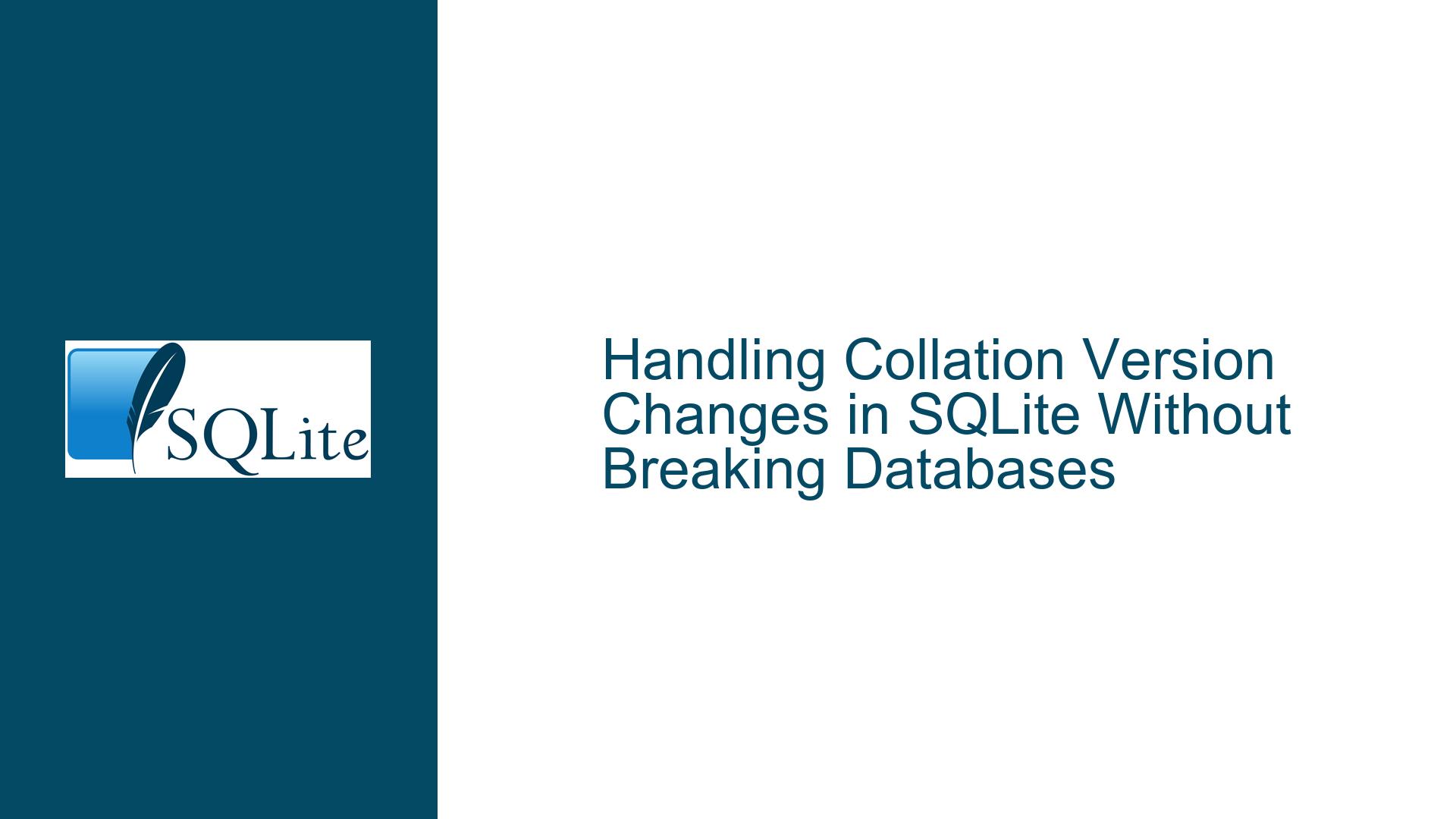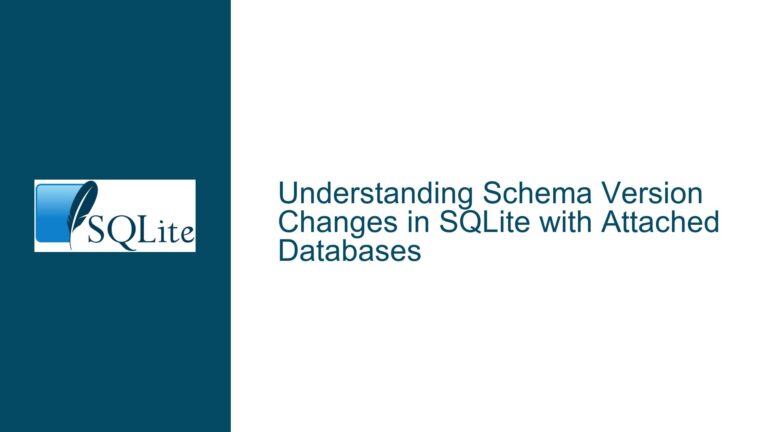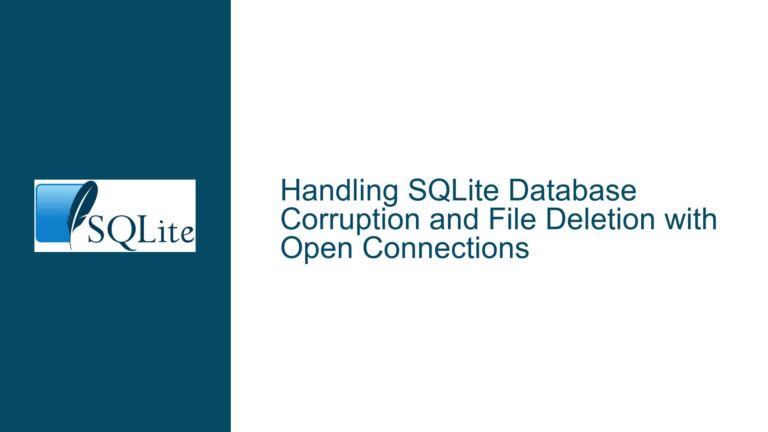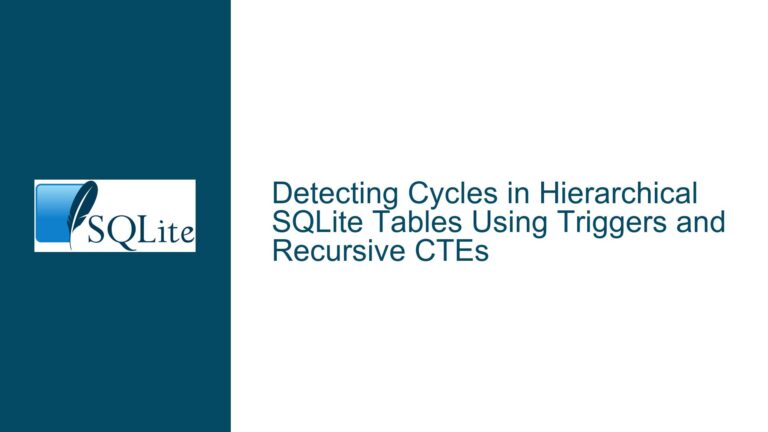Handling Collation Version Changes in SQLite Without Breaking Databases
Collation Stability Requirements and Database Integrity Risks
Issue Overview
Collations in SQLite are user-defined or built-in functions that determine how text values are compared and sorted. These collations must adhere to strict mathematical properties (reflexivity, symmetry, transitivity, and antisymmetry) to ensure consistent and reliable query results. When a collation’s behavior changes—such as due to Unicode updates, operating system locale revisions, or custom collation logic modifications—the existing database indexes that rely on that collation may become invalid. This invalidation occurs because the stored order of data no longer aligns with the new collation rules.
For example, consider a collation Unicode_Windows_en_US that uses the Windows API CompareStringEx for sorting. If Microsoft updates the sorting algorithm in a Windows version upgrade, strings previously sorted as "A < B" under the old collation might now be ordered as "B < A". Indexes (including implicit ones like PRIMARY KEY in WITHOUT ROWID tables) built using the old collation will contain entries ordered according to the old rules. Querying these indexes with the new collation can return incorrect results, cause constraint violations, or even corrupt the database if the collation’s properties are violated.
The critical question is: How can collation changes be safely applied to a persisted database without introducing inconsistencies? The answer lies in understanding how collations bind to database structures, the role of indexes in enforcing data order, and the mechanisms SQLite provides to rebuild these structures.
Root Causes of Collation-Induced Database Inconsistencies
Collation Function Volatility
Collation functions are not static. They can change due to:
- Unicode Standard Updates: New characters or revised sorting rules.
- Operating System Updates: Changes in locale-dependent sorting APIs (e.g., Windows
CompareStringEx). - Custom Logic Revisions: Bug fixes or feature additions in user-defined collations.
When a collation’s behavior changes, any index that uses it becomes a liability. For instance, a UNIQUE constraint enforced by an index assumes that the collation’s equality checks are stable. If two values previously considered distinct become equal under the new collation, the UNIQUE constraint will be violated during attempts to rebuild the index.
Index-Persisted Collation Rules
SQLite does not store the collation logic itself in the database. Instead, it assumes that the collation registered under the same name will behave identically for the lifetime of any index using it. This design choice optimizes performance but creates a hidden dependency: altering a collation’s behavior without rebuilding dependent indexes breaks the assumption that the index order matches the collation’s current rules.
Implicit Indexes and Schema Dependencies
Explicit indexes (e.g., CREATE INDEX) are obvious candidates for rebuilding, but implicit indexes pose subtler risks:
PRIMARY KEYinWITHOUT ROWIDtables directly stores data in index order.UNIQUEconstraints create hidden indexes.COLLATEclauses in column definitions propagate to indexes.
A collation change affecting any of these structures requires a full rebuild to maintain consistency.
Mitigation Strategies for Safe Collation Updates
Step 1: Pre-Change Validation with PRAGMA Integrity Checks
Before altering a collation, validate existing database integrity:
PRAGMA integrity_check;
This command checks index consistency, including collation order. If it reports errors, resolve them (e.g., fix corrupt indexes) before proceeding.
Note: PRAGMA quick_check skips collation order validation for speed. Use it for preliminary checks but rely on integrity_check for thorough validation.
Step 2: Rebuilding Indexes with REINDEX
After updating the collation function, immediately execute:
REINDEX <collation-name>;
This rebuilds all indexes using the specified collation. For example, after updating Unicode_Windows_en_US, run:
REINDEX Unicode_Windows_en_US;
Critical Considerations:
- Atomic Operation: Perform
REINDEXbefore any other database operations to prevent partial updates. - Transaction Boundaries: Wrap
REINDEXin a transaction to ensure rollback on failure. - Storage and Performance: Rebuilding large indexes (especially in
WITHOUT ROWIDtables) may require significant temporary storage and time.
Step 3: Handling Unique Constraint Violations
If the new collation causes previously distinct values to become equal, REINDEX will fail with a UNIQUE constraint error. Mitigate this by:
- Pre-REINDEX Data Cleanup:
DELETE FROM table WHERE rowid NOT IN (SELECT MIN(rowid) FROM table GROUP BY column COLLATE new_collation);This retains the first occurrence of duplicates.
- Constraint Relaxation: Temporarily disable constraints using
PRAGMA ignore_check_constraints=1;, but exercise extreme caution as this can lead to data inconsistency.
Step 4: Post-REINDEX Integrity Verification
After rebuilding indexes, rerun integrity checks:
PRAGMA integrity_check;
Resolve any new errors, which may indicate edge cases not handled during data cleanup.
Step 5: Versioning and Documentation
- Collation Versioning: Append version suffixes to collation names (e.g.,
Unicode_Windows_en_US_v2). This allows phased transitions and rollbacks. - Schema Migration Scripts: Automate collation updates with scripts that handle
REINDEX, error recovery, and logging.
Best Practices for Collation Management
- Isolate Collation Changes: Deploy collation updates during maintenance windows with database backups.
- Monitor for Drift: Periodically check
PRAGMA integrity_checkin production to detect silent corruption. - Test Extensively: Use staging databases with real-world data to simulate collation changes and measure performance impact.
By adhering to these steps, developers can safely evolve collation logic in SQLite databases while minimizing risks of corruption or inconsistency. The key is recognizing that collations are not just runtime functions but integral components of the database’s physical structure, necessitating disciplined versioning and rebuild procedures.






